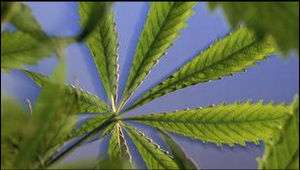Hunter Valley cannabis infestation

The Hunter Valley cannabis infestation was an infestation of the marijuana plant, Cannabis sativa in the Hunter Valley in New South Wales, Australia. At its peak, the infestation covered about 30 square kilometres (12 sq mi). It took nine years for the New South Wales government to eradicate it.[1]
History
The Hunter Valley is a fertile agricultural region situated on the east coast of Australia, approximately 160 kilometres (99 mi) north of Sydney. Due to a mild climate, an abundance of water and alluvial soils, the area is well known for its wine production, lumber, dairy farming and poultry industries. The Hunter River flows through Singleton, and empties into the Pacific Ocean at the city of Newcastle.
Cannabis sativa seeds first arrived in Australia in 1788 on the First Fleet at the request of Sir Joseph Banks.[2] The blueprint for the New South Wales colony, approved by the British Cabinet in 1786, envisaged Australia as a commercial colony producing hemp.[2]
In 1892, the Department of Agriculture distributed Cannabis sativa seeds to hundreds of farmers in New South Wales as an experiment in the cultivation of hemp due to the high prices of binding-twine at the time.[3] From 1840 to the early 1900s, Australians used cannabis as a medicinal herb and Cigares de Joy (cannabis cigarettes) were sold over the counter.[4]
The Single Convention on Narcotic Drugs, an international treaty adopted in 1961, broadened the scope of controlled substances to include Cannabis sativa. Due to rising drug use among young people and within the counter-culture movement, government efforts to enforce prohibition were strengthened in the 1960s.
Discovery
In the spring and summer of 1963, attention was called to the presence of large amounts of Cannabis sativa growing on river banks, along creeks, and near irrigation channels in Hunter Valley. The New South Wales Department of Agriculture and Fisheries dispatched field officers to the affected areas to identify the plants.
The discovery created a sensation in the press. One Sydney newspaper reported the find under the headline "Love Drug found in the Hunter Valley". The discovery also aroused much interest in the fledgling bohemian community. In April and May of each year of the infestation, small but determined bands of marijuana devotees evaded detection by police and land owners as they harvested the flowering tops of the plants. These individuals became known as weed raiders. Much of the resulting cannabis was then smuggled to Sydney, where it was dried, cured and illegally distributed.
Marijuana smoking in Australia exploded in the next several years.[5] Local dairy farmers demanded something be done to protect their valuable pasture lands from trespassers. The local chief of the New South Wales Police Force in the Hunter Valley publicly declared that the infestation would be eradicated "within six to eight weeks". The eradication effort would take nine years.
Eradication
The Department of Agriculture and Fisheries established a joint task force with the Police Force to begin a program of eradication on a "search and destroy" basis. Initially, plants were pulled by hand and then burned. With the reappearance of the freely seeding cannabis the next spring, hand pulling was no longer a viable option on its own. Herbicide control was introduced on an ad hoc basis during the mid-summer months. At the height of the infestation, cannabis covered some 30 square kilometres (12 sq mi) of the Hunter Valley along 63 kilometres (39 mi) of the Hunter River downstream from Singleton. Infestations ranged from small clumps of plants to dense fields of cannabis ranging up to 8 hectares (20 acres).
Eventually, it was decided to use preparations of powerful, highly toxic herbicides including 2,4-D, amitrole and bromacil to control the outbreak. Officers using knapsack sprayers were deployed to deal with smaller infestations, while large areas of cannabis were sprayed from small crop dusting aircraft. By 1971, only a small number of plants were found by the regular summer patrols of field officers, that could easily be pulled by hand. The eradication of the infestation was finally declared successful in 1972.
References
- ↑ The Eradication of Cannabis sativa L. with Herbicides in the Hunter River Valley, N.S.W., Australia, United Nations Office on Drugs and Crime
- 1 2 The Sydney Connection Jiggens, John 2004
- ↑ The Agricultural Gazette of New South Wales Notes on Experiments with Hemp (Cannabis Sativa) in New South Wales G. Valder
- ↑ Schaffer Library of Drug Policy Cannabis in Context: History, Laws and International Treaties
- ↑ Jiggens, John (2005-10-28). "The Cost of Drug Prohibition in Australia" (PDF). Centre for Social Change Research, Queensland University of Technology.